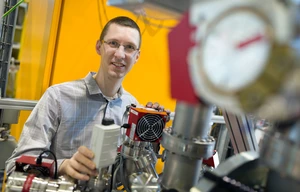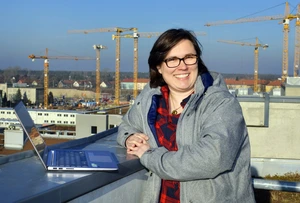News

Highly sensitive method for detecting ion pairs in aqueous solution developed
For the first time, scientists detect the specific non-local electron transfer process in water:
Scientists of the Helmholtz-Zentrum Berlin, Freie Universität Berlin, Universität Heidelberg, and the University of Chemistry and Technology Prague have empirically detected a very specialised type of electron…

HZB and Freie Universität Berlin are establishing the joint research group “Macromolecular Crystallography”
This practical education for budding biochemists is unique in Germany:
For eight years, HZB’s “Macromolecular Crystallography” workgroup has been successfully cooperating with the “Structural Biochemistry” research group headed by Prof. Markus Wahl at the Freie Universität Berlin. They…

Adlershof Journal March/April 2017
The High Energy Neighbourhood: How We Recharge Our Batteries:
View into EMIL: Research on new energy materials // Access control: IT company entri develops software-based systems // Pocket-Sized Laboratory: Legionella quick test developed //

Earth Hour – Saving the world in 60 minutes?
The world will turn off the lights again on March 25th:
Would you like to feel like James Bond and save the world just a tiny bit? If so, the Earth Hour organised by the WWF is just the thing for you. You turn off the lights for one hour once a year and save the earth from…

In conversation with Tobias Kirschnick
Head of the Innovation and Business Incubation Centre (IGZ) in Adlershof since October:
In this interview, Tobias Kirschnick lets us in on his plans for the centre’s reorganisation. Kirschnick, who is now in his late thirties, started off with a degree in business management at the Free University…

With Passion
Anton Nagy builds testing facilities for customers from the chemical industry and is fascinated by Berlin:
Berlin in the 1990s: “Really awesome!” His successful application as a PhD student at the Fritz-Haber-Institute and the collegiality back then: “Really awesome.” When you meet Anton Nagy, you experience a person who…

A Model Neighborhood for Energy Efficiency
How the Science City Adlershof will save a third in primary energy consumption:
Intelligent technologies will help the Science City Berlin Adlershof, which covers an area of 420 hectares, become energy-efficient. A project network has been aiding the process with key insights. The goal was…

Efficient and convenient
Energy-efficient living in so-called Plus-Energy-Houses and so-called “Powerhouses”:
Many single-family houses are now increasingly built as passive or plus-energy houses. Several Adlershof-based projects aim to show that multi-family residential homes can also combine high energy efficiency with a…

Going Strong after 25 Years
Loptek, a company specialised on fibre glass, has moved manufacturing to the Technology Park:
2017 was a special year for Loptek GmbH & Co. KG. The company, which specialises on fibre optical light guides, fiber optic systems and precision mechanics, moved into its brand-new headquarters in Adlershof at the…

The Welcome System
The IT company entri developes software-based systems for access control:
Visitors are greeted by the word “entri” in huge, blue letters when they enter through the glass front door. Naturally, a company named “entri” would excel at welcoming guests to its headquarters. It’s their business…

Why Scientists X-ray Solar Cells
The electron storage ring BESSY II and the transition to clean energy:
Researchers at the “EMIL” laboratory of the Helmholtz-Zentrum Berlin für Materialien und Energie GmbH explore possible components for the Energiewende – Germany’s transition to clean energy. One group exposes material…

Spaces of Knowledge Creation
Economic geographer Suntje Schmidt explores the development of creative spaces:
How do the things work that surround us? Where does innovation come from and which conditions does it need to thrive? These are some of the questions tackled by economic geographer Suntje Schmidt. She recently became…

The Pocket-Sized Laboratory
The start-up diamond inventics finds legionella at record speed:
Precise, fast, energy and water-saving and about the size of a credit card. An innovative chip system can detect pathogenic microorganisms in water samples on the ground. The test was developed by diamond inventics, a…

5G can pave the way for the digital revolution
Test field for studying the impact of 5G on the energy sector at Adlershof and in Bonn:
According to Deutsche Telekom, Ericsson and distribution network operator Stromnetz Berlin, 5th generation (5G) communication networks could have a significant impact on the energy sector. The partner companies are…

Lattice of nanotraps and line narrowing in Raman gas
Decreasing the emission linewidth from a molecule is one of the key aims in precision spectroscopy. One approach is based on cooling molecules to near absolute zero. An alternative way is to localize the molecules on…

The view into the crystal
MBI scientists recorded ultrasmall atom motions with ultrashort x-ray pulses:
Periodic motions of atoms over a length of a billionth of a millionth of a meter (10-15 m) are mapped by ultrashort x-ray pulses. In a novel type of experiment, regularly arranged atoms in a crystal are set into…
Science is International
Statement of the Science Organisations in Germany to the executive order of President Trump:
The generation of scientific insights is contingent upon discourse that is forthright, unfettered and international. It hinges on the interdisciplinary personal exchange between academic disciplines, nations and…

Mars' North Pole – Chronicle of the Martian climate
A colour mosaic of Mars' north polar cap was created from 32 images acquired by the HRSC camera:
Mars' northern hemisphere is currently experiencing winter. A newly generated colour mosaic depicts the extraordinary, almost perfectly symmetrical pattern of Mars' north polar ice cap, 1100 kilometres in diameter.…

Green light for upgrading BESSY II into a variable-pulse-length storage ring (BESSY-VSR)
General Assembly of the Helmholtz Association unanimously endorses the realisation of a worldwide unique accelerator project at the synchrotron radiation source BESSY II:
The General Assembly of the Helmholtz Association unanimously supports Helmholtz-Zentrum Berlin’s proposed concept for upgrading BESSY II into a variable-pulse-length storage ring (BESSY VSR). The body of chairpersons…

Solar based hydrogen generation: EU-project PECSYS aiming for technological breakthrough
Development of demonstrators measuring up to ten square meters in area planned:
The HZB is coordinating a Horizon 2020 EU project that is expected to develop an economically feasible technology for solar based hydrogen generation. Solar energy shall thereby be converted into chemical energy that…